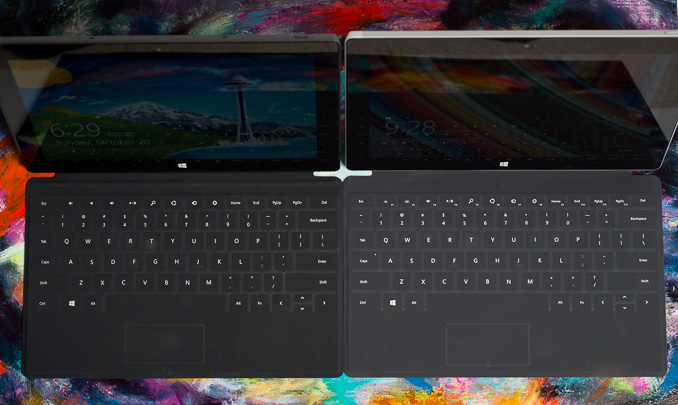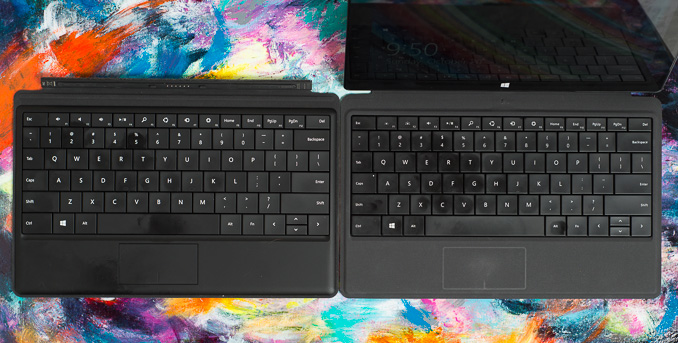Microsoft Surface 2 Review
by Anand Lal Shimpi on October 21, 2013 12:00 AM ESTThe New Touch/Type Covers
When I was first introduced to the folks who built Surface I was told about the three non-negotiable parts of its design: the tablet, the kickstand and the cover. While most tablet covers end up being protective accessories, the first party covers for Surface are an integral part of the overall experience.
Microsoft offers two cover options: the touch cover and the type cover. Both integrate full qwerty keyboards into a display cover that attached magnetically, but they differ in keyboard type. As its name implies, the touch cover integrates a pressure sensitive keyboard with no moving parts. By comparison, the type cover uses keys that physically move. Neither accessory is included with any Surface device and will set you back $119 for the touch cover and $129 for the type cover. They are expensive, but absolutely worth it if you’re going to do any sort of typing on your Surface.

Old (left) and new (right) touch covers
With the second generation of Surfaces, Microsoft improved both covers. They both get marginally thinner and backlit keys. The backlight effect is great, although there are only three keyboard backlight brightness levels.
The touch cover sees the biggest improvement as Microsoft moved from having only 80 pressure sensors in the previous design to 1092 sensors. The result is an incredible increase in accuracy. I find that I can type a lot lighter on the new touch cover and still have my keystrokes recognized. I also make far fewer mistakes on the new touch cover. While I felt that the initial touch cover was usable, this one is almost good enough to be a physical keyboard replacement.
| 2nd Generation Touch/Type Cover Thickness | ||||||||||
| Touch Cover | Type Cover | |||||||||
| 1st gen | 3.35 mm | 5.7 mm | ||||||||
| 2nd gen | 2.91 mm | 5.22 mm | ||||||||
| iPad 4 Smart Cover | 2.2 mm | |||||||||
Despite the tremendous improvement in accuracy on the new touch cover, I still prefer the type cover. I wrote long segments of this review on the new touch cover, but I had a much better time doing so on the type cover. Microsoft has reduced thickness on the new type cover, in part by reducing key travel. I’m happy to say that the reduction in key travel isn’t noticeable, and I’m able to type just as quickly and as comfortably as I could with the first gen type cover. The difference in thickness between the two is very small (~2.3mm) and you get a much more usable keyboard out of the type cover.

Old (left) and new (right) type covers
The new type cover ditches the clickpad in favor of a pressure sensitive trackpad. I’m a bit happier with the new trackpad but it’s still largely a pain to use for anything other than basic mousing. Two finger scrolling works ok, but any click and drag use is seriously frustrating thanks to the small size of the unit and no physical buttons. Thankfully there’s a 10.6-inch touchscreen a few inches away from you that works a lot better.
The new type cover ditches the felt backing of the previous model in favor of a soft touch plastic. Type covers are also now available in four colors (purple, pink, blue and black).
Remember that both of these covers make a physical connection to Surface, both to stay attached to the device as well as to transmit data. There’s no chance of running into spectrum crowding issues like you would with a 2.4GHz wireless keyboard, these keyboards are as good as any other wired device. The covers make a very strong magnetic connection to the device. The connection is strong enough to withstand picking up even a Surface Pro 2 by the attached cover and lightly swing it back and forth without the two separating. This is of course predicated on you properly attaching the cover to the tablet, but the strong magnets do a fairly good job of lining up and doing that as well.
The only issue I had with the new covers is that sometimes the trackpad would stop working after coming out of sleep. The keyboard worked fine, but the trackpad would just disappear. The only solution is to disconnect/reconnect the cover, which fixed it every time. I informed Microsoft about the issue, it’s something they’re aware of internally and plan to issue an update to fix.










139 Comments
View All Comments
Daniel Egger - Monday, October 21, 2013 - link
Have you actually looked around in the Store? Half a dozen Solitaire clones and a few Poker games but that's about it. He prefers playing more exotic Solitaire versions, Skat, Schafkopf, Doppelkopf, Bridge -- in a nutshell anything that's not Klondike or Poker and you wouldn't believe how many CDs and DVDs with Windows games he has that actually contain hundreds to thousands *unique* card games.Wolfpup - Thursday, October 31, 2013 - link
I'm SERIOUSLY considering buying Surface 2 for exactly this reason, BUT I'm still paranoid she's going to be able to break it, install malware from the Windows store or SOMETHING...chizow - Monday, October 21, 2013 - link
Really wish there was a Bay Trail-T in this Surface 2 chassis, I'd pay $500 for that in a heartbeat for the full x86 Win8.1 support. I still feel Surface Pro 2 is too expensive for what it is, but Windows RT just isn't flexible enough with app support to drop to the ARM-based Surface 2.Instead I'll probably look at the Asus Transformer T100 instead.
Braumin - Monday, October 21, 2013 - link
On the last go around, I would have agreed with you. The Surface RT should have come with Clovertrail - it was faster than Tegra 3, and the app store was pretty much empty on day 1.Now though, I have an use a Surface RT (just upgraded to 8.1) and honestly I don't think x86 is really needed in this kind of device. The desktop is not great with touch, nor with something this small. The app store is way better than it was now. The graphics performance of Tegra 4 is way better than Bay Trail too. CPU performance is still lower of course.
Also, this go around there seems to be some excellent choices on the OEM side which are all using Bay Trail, so if a guy wants x86, there's plenty of choice! The Dell Venue Pro 11 looks excellent, and I'm interested in seeing how the 8" tablets do. The price is certainly right from both Dell and Lenovo. Last year, the OEMs didn't know what to make so everything they made did flips and twists, and no one really made a good tablet.
stanwood - Monday, October 21, 2013 - link
Braumin, you touch on exactly the issue I'm facing in choosing an inexpensive tablet for my mother. Like most people, she is not shopping cross-platform. It's going to run Windows. But should it be a Surface 2 with Tegra 4 or maybe a Venue Pro 11 with Bay Trail? While I appreciate the performance comparison with ARM tablets here I hope we see a Bay Trail table review with comparisons to Surface 2.Braumin - Wednesday, October 23, 2013 - link
It's a tough call I would wait and see what the Venue Pro 11 looks like. The RT side though is perfect for people who don't need to run x86 apps. It's going to get no viruses, it won't get bloated over time. They won't be able to install junk in the browser or system tray that slows the machine down and kills the battery.Personally I'd get a Surface 2, or possibly a Lumia 2520. They cost a bit more but the quality of the Surface is really at the top end.
heelo - Monday, October 21, 2013 - link
"I’d love to see Surface 2 with type cover retail for $399, I feel like at that price point it’d be at least a competitive sell."Part of me thinks that MS needs to stay the course here with the "premium tablet as budget laptop" approach that they've adopted with the Surface RT models. I feel like the "one device instead of two" marketing pitch requires a premium angle, and I think that's the build quality and fit and finish. With this approach, MS doesn't have the same luxury the Android competitors had in being able to undercut the iPad by actually selling less device (not to mention the fact that MS needs to run the program with legitimate P&L considerations, rather than zero-margin strategic market initiatives like the Nexus and Kindle programs).
Yet another part of me agrees with Anand, and believes that "Surface + cover for $399" should be a design requirement for Surface 3.
Perhaps the answer is for MS to create a Nexus-like program where they partner with certain OEMs and have them produce $299-level 10" RT devices that have their own (presumably less robust) kickstands and incorporate the Surface keyboard cover connectors? It may not be possible to produce something viable at that price point today, but maybe next summer?
flyingpants1 - Monday, October 21, 2013 - link
Well price competition is pretty important. At $399 it would compete price wise with the Nexus 10, and $100 cheaper than an iPad, maybe then some people would actually buy it.savagemike - Monday, October 21, 2013 - link
With a type cover then probably closer to $200 cheaper and I think that is where they'd need to be.savagemike - Monday, October 21, 2013 - link
The problem is that the Surface with keyboard cover is pretty much the same money as an iPad with any number of keyboard covers which are available for it. It might come in $30 less or so but that is not enough to drive decisions. And chances are more than high that in a week Apple is going to launch a new ipad which will surely have something new.The only reason to recommend a surface to anyone over an iPad is Office and honestly I think MS overestimates the value of Office to most consumers. Unless you need it for work or it is required for school then it really is not needed. If you do need Office for work then there is a decent chance you will be sporting a laptop or Surface Pro. If for school then maybe. But I think you've found a pretty small market there.
End of the day the only thing which will help them with this round of Surface and RT is that they are probably clever enough not to build so many up front. So the write-down will not be as big at the end of this cycle.
MS has deep pockets though and if this segment is important to them then they'll be back.